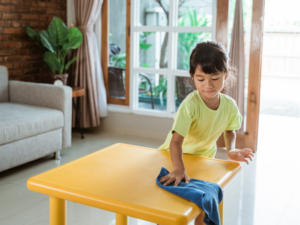In this article, I want to share how to safely and effectively use planned ignoring as a strategy to handle tantrums and other problem behaviors.
As an occupational therapist (OT), I have a “bag of tricks” to help students function & participate in a school setting. As a mother of a 5-year-old son with Autism & a 3-year-old (going on 30) neurotypical daughter, sometimes my “tricks of the trade” go out the window! I give so much energy to my students that I’m exhausted when I get home. As a result, I have less patience for my own children.
The strategy of planned ignoring
One strategy I use to address behavioral concerns in school is planned ignoring. I tried this strategy with my own son & was surprised by the result. I have no idea why I was surprised because I used this with my students, yet I was still stunned. In this blog post, I will talk about my experiences & tips for using planned ignoring.
A tantrum story
One Sunday afternoon, my husband & daughter were napping. My son (EJ) & I were upstairs. I was busy cleaning the kitchen & EJ was supposed to be watching TV. Instead, he was playing with his father’s earbud case. On SEVERAL occasions, I have told EJ not to touch this item. To be honest, I was annoyed & upset because I believe he knows & understands not to touch the case, but he continues to do so. I told EJ that I would turn off the TV because he wasn’t watching it & he touched the earbud case. EJ said, “no,” but I turned it off anyway. As soon as I did so, EJ made a high-pitched scream that hurt my ears (it was so PAINFUL)!
Applying planned ignoring at home
Instead of yelling back, I put on my headphones & continued cleaning the kitchen. I did not look at him, I said nothing, & gave him no facial expression. What happened next was so interesting! Since I wasn’t reinforcing this disruptive tantrum behavior, EJ began to scream louder. Can you imagine how painful this would be without my headphones!?!? When screaming didn’t work, EJ threw his body on the floor. I didn’t give in; thank goodness for noise-canceling headphones!
When throwing his tantrum didn’t work, EJ bumped his body into mine. I walked around him & continued my task. Do you know what happened next? He stopped the tantrum! I was shocked! I didn’t have a chance to praise him because his screaming woke up my husband & he ended up disciplining EJ using that deep stern father voice. Yet, I still learned something in this situation. When done correctly, planned ignoring does work.
Four tips for implementing planned ignoring in your own home
- Only ignore disruptive behavior that is not harmful to the child or family. For example, ignoring a child running towards the street is NOT safe.
- While ignoring, DO NOT LOOK AT THE CHILD! Look away & keep a neutral facial expression. Do not speak. Do not make physical contact. Do not make eye contact. No scolding or reprimanding. Feel free to wear headphones if necessary.
- If misbehavior occurs while asking the child to do something, continue making requests with minimal physical guidance, if necessary. You can also wait it out until the request is completed. You do not want the child to get out of the task by misbehaving. Once you believe the child understands the request, do not repeat it.
- Once you observe the behavior you desire, provide attention. Make sure the child gets more attention for appropriate behavior than misbehavior.
Planned ignoring doesn’t mean to just walk away. Safety is of the utmost importance!
If a child throws items, hits, etc., you can intervene to remove or block the child from hitting. As soon as the child demonstrates desired behavior, give an abundance of praise. I’d love your thoughts on this strategy or if you have tried it. Leave a comment & let me know your thoughts.
Reach out to Cyrstal to set up some time to discuss this parenting strategy or other methods to manage behavior at home.
Related reads on managing behavior:
Everything you need to know about meltdowns




